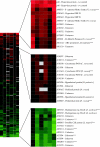Use of cDNA microarrays to monitor transcriptional responses of the chestnut blight fungus Cryphonectria parasitica to infection by virulence-attenuating hypoviruses
- PMID: 14665460
- PMCID: PMC326648
- DOI: 10.1128/EC.2.6.1253-1265.2003
Use of cDNA microarrays to monitor transcriptional responses of the chestnut blight fungus Cryphonectria parasitica to infection by virulence-attenuating hypoviruses
Abstract
Hypoviruses are a family of cytoplasmically replicating RNA viruses of the chestnut blight fungus Cryphonectria parasitica. Members of this mycovirus family persistently alter virulence (hypovirulence) and related fungal developmental processes, including asexual and sexual sporulation. In order to gain a better understanding of the molecular basis for these changes, we have developed a C. parasitica cDNA microarray to monitor global transcriptional responses to hypovirus infection. In this report, a spotted DNA microarray representing approximately 2,200 C. parasitica genes was used to monitor changes in the transcriptional profile after infection by the prototypic hypovirus CHV1-EP713. Altered transcript abundance was identified for 295 clones (13.4% of the 2,200 unique cDNAs) as a result of CHV1-EP713 infection-132 up-regulated and 163 down-regulated. In comparison, less than 20 specific C. parasitica genes were previously identified by Northern analysis and mRNA differential display as being responsive to hypovirus infection. A 93% validation rate was achieved between real-time reverse transcription-PCR results and microarray predictions. Differentially expressed genes represented a broad spectrum of biological functions, including stress responses, carbon metabolism, and transcriptional regulation. These findings are consistent with the view that infection by a 12.7-kbp hypovirus RNA results in a persistent reprogramming of a significant portion of the C. parasitica transcriptome. The potential impact of microarray studies on current and future efforts to establish links between hypovirus-mediated changes in cellular gene expression and phenotypes is discussed.
Figures


References
-
- Buck, K. W. (ed.). 1986. Fungal virology—an overview, p. 2-84. CRC Press, Inc., Boca Raton, Fla.
-
- Bustin, S. A. 2002. Quantification of mRNA using real-time reverse transcription PCR (RT-PCR): trends and problems. J. Mol. Endocrinol. 29:23-39. - PubMed
Publication types
MeSH terms
Substances
Grants and funding
LinkOut - more resources
Full Text Sources

